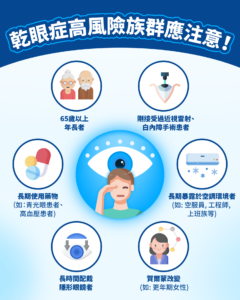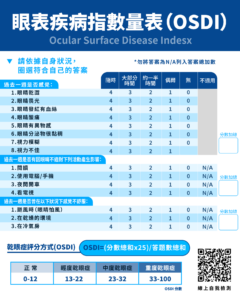After myopic laser or cataract surgery, patients’ vision does not “light up” as expected, but instead becomes blurry and painful. It turns out that dry eyes are to blame! The Taiwan Society of Cataract and Refractive Surgeons (TSCRS) reminds patients of the high prevalence of dry eye symptoms, which are reported or diagnosed in one in three people, and that dry eye may be a complication of myopic laser surgery and cataract surgery.
As summer vacations come to an end, many people take advantage of the long vacations to have myopic laser surgery, but neglect to take care of their eyes after surgery, resulting in dry eye syndrome! Legislator Lai Pin-Yu, a patient herself, shared her experience of suffering from dry eye syndrome for a long time, which was so severe that she could not work normally. However, since she had to undergo myopic laser surgery, she sought her doctor’s help to control her dry eyes first. After the laser surgery, she followed the doctor’s instructions for regular follow-ups and was finally free of her nearsightedness and avoided the risk of worsening dry eye after the surgery!
Dr. Sun Chi-Chin, President of the TSCRS, explains that dry eye has become a warning sign for eye health nationwide due to the constant use of 3C products in our lives. Dry eye is also a common complication of myopic laser and cataract surgery and can occur within a few days of surgery. However, many patients are unaware of the relationship between eye surgery and dry eye or neglect the importance of ongoing follow-up, which can lead to worsening symptoms and potentially irreversible vision loss. The public is reminded to evaluate for dry eye before surgery and to be vigilant and cooperative in managing this condition after surgery. Dr. Hsu Shiuh-Liang, Director of the TSCRS, shared that artificial tears are the most basic treatment for dry eye. Currently, there are many different artificial tear products on the market. Post-operative patients are advised to choose artificial tears that can maintain comfort for a longer period of time, contain moisturizing ingredients, and are preservative-free, and to avoid excessive eye use in order to stay away from dry eye and maintain bright vision!
Nearly 7 million people in Taiwan suffer from dry eye syndrome.
Patients undergoing cataract surgery and laser refractive surgery for myopia should be more aware of the dry eye syndrome!
Dry eye syndrome has always been a common cause of outpatient visits to eye clinics. According to the National Health Insurance Administration of the Ministry of Health and Welfare, nearly one-third of Taiwan’s population may suffer from dry eye, with the number of patients increasing by an average of 700,000 per year! President Sun Chi-Chin explained that many people think that dry eye is just ” the dryness of the eyes,” but in fact, patients often experience foreign body sensation, pain, burning, photophobia and itchy eyes. Because of the discomfort associated with dry eye, patients may not be interested in doing anything. If they don’t actively seek medical attention, the condition can lead to corneal rupture and perforation in severe cases, further affecting their vision.
Women over the age of 65 and menopausal women are at high risk for dry eye. Lifestyle habits can also contribute to the development of dry eye, such as: office workers, engineers and flight attendants who are exposed to air conditioning for long periods of time, long term contact lens wearers, or long term users of medications for glaucoma and high blood pressure. Dry eye is also a common complication in patients who have recently undergone myopic laser and cataract surgery. In Taiwan, there are approximately 240,000 cataract surgeries per year, of which 9.8% of patients suffer from dry eye syndrome, and of the 15,000 myopic laser surgeries per year, approximately 20% of patients suffer from significant worsening of dry eye syndrome in the first six months after surgery. President Sun Chi-Chin reminds the high-risk group to use a self-examination scale (OSDI) for initial evaluation and to seek professional advice if dry eye is suspected!
Dry eye evaluation before surgery! Postoperative management should not be ignored!
Patients should remain vigilant and have regular follow-up visits.
Director Hsu Shiuh-Liang of the TSCRS explains that the disinfectant solution, instruments, and surgical lights used during surgery can damage the epithelial tissue on the surface of the eye, which in turn affects the nerve conduction in the eye, decreases tear secretion, and affects the stability of the tear film. Strong eye drops used after surgery to prevent infection can also cause dry eyes after surgery. The public is advised to have a thorough evaluation by a physician before undergoing eye surgery. If the dry eye is already moderate or above, it is recommended that the dry eye be treated to a manageable level before undergoing surgery.
Patients should also be aware of the onset or worsening of dry eye after surgery. Director Hsu Shiuh-Liang shared that there was a patient who experienced blurred vision and itchy eyes one week after cataract surgery. He thought the surgery was a failure, but realized it was dry eye when he returned to the clinic. The dry eye was thought to be due to the effects of the anti-inflammatory eye drops used after surgery. After reducing the use of eye drops and using preservative-free artificial tears, the situation gradually improved. For patients who have dry eye disease prior to surgery, the importance of continued treatment after surgery should not be overlooked. Director Hsu Shiuh-Liang shared that he once had a patient with moderate to severe dry eye who was under stable control before surgery, but two to three days after cataract surgery, his eyes developed redness, swelling and pain. Four or five days after surgery, the cornea was even perforated and the surface was broken. The patient returned to the clinic and was diagnosed with dry eye. Fortunately, the patient gradually recovered with treatment. Therefore, post-operative patients are reminded to be vigilant and seek professional advice as soon as possible if they experience symptoms such as dry eyes!
Three keys to evaluating artificial tears
People are encouraged to talk to their doctor about how to avoid dry eye after surgery!
Artificial tears are the first line of treatment for dry eye patients. In recent years, a variety of artificial tears have been developed for different purposes. The Taiwan Society of Cataract and Refractive Surgeons (TSCRS) provides three keys to selecting artificial tears:
Key Ingredients: It is recommended that post-surgical patients choose a product that provides better tear film adhesion or longer comfort after dispensing.
Excipients: Hyaluronic acid is a common ingredient that, when combined with the efficacy of the main ingredient, is often effective in prolonging moisturization and relieving dry eye symptoms.
Preservative-free: The toxicity of preservatives in artificial tears can build up in the cells of the ocular surface over time, causing irreversible damage. It is recommended that you use preservative-free, individually wrapped eye drops, which are also easy to carry with you. Most artificial tears on the market are designed with a resealable cap. However, it is important to note that preservative-free individual packs of artificial tears should be discarded if they are not used within 24 hours of unpacking to avoid compromising the quality of the artificial tears.
If you don’t feel comfortable using a single pack, or if it’s inconvenient to use, choose a bottle that contains a safe and gentle preservative to minimize damage to corneal cells.
President Sun Chi-Chin reminds that if you experience dry eyes after surgery, you should actively manage them, use the proper tear drops as prescribed by your doctor, avoid excessive use of 3C products in your daily life, and maintain a normal routine. In addition, to establish the correct knowledge of dry eye treatment, the TSCRS is expected to release guidelines for dry eye treatment by the end of this year, so that more patients can benefit from treatment, stay away from dry eye, and improve their quality of life!
–
References
- Kuo YK, Lin IC, Chien LN, Lin TY, How YT, Chen KH, Dusting GJ, Tseng CL. Dry Eye Disease: A Review of Epidemiology in Taiwan, and its Clinical Treatment and Merits. J Clin Med. 2019 Aug 15;8(8):1227. doi: 10.3390/jcm8081227. PMID: 31443274; PMCID: PMC6722537.
- Hung N, Kang EY, Lee TW, Chen TH, Shyu YC, Sun CC. (2021). The Risks of Corneal Surface Damage in Aqueous-Deficient Dry Eye Disease: A 17-Year Population-Based Study in Taiwan. American Journal of Ophthalmology, Volume 227, Pages 231–239. https://doi.org/https://doi.org/10.1016/j.ajo.2021.03.013
- National Health Insurance Administration of the Ministry of Health and Welfare. <Number of cataract surgeries in Taiwan in 2020>
–
Health Education Pictures for Reference



–
At the Press Conference

– (From left to right) Director Hsu Shiuh-Liang, President Sun Chi-Chin, Legislator Lai Pin-Yu

– Dr. Sun Chi-Chin, President of the TSCRS

– Dr. Hsu Shiuh-Liang, Director of the TSCRS


